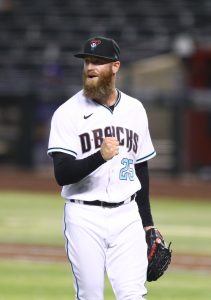Yankees southpaw James Paxton will go the next couple days without throwing after feeling soreness following Wednesday’s session, manager Aaron Boone told WFAN (via Kristie Ackert of the New York Daily News). It’s unclear how much longer Paxton will be sidelined from the flexor strain that sent him to the IL on Aug. 21, but as Ackert notes, time is running out for him to return – at least to the Yankees’ rotation – during the regular season. Paxton’s problems, both in terms of injury and performance, are among the reasons the Yankees’ starting staff has disappointed this year. Although the 31-year-old dealt with his share of injuries in prior seasons, he typically fared well when healthy. In 2020, though, Paxton has stumbled to a 6.64 ERA over five starts and 20 1/3 innings.
- Rays manager Kevin Cash hasn’t ruled out regular-season returns for third baseman Yandy Diaz or catcher Mike Zunino, Marc Topkin of the Tampa Bay Times tweets. Diaz went to the IL on Sept. 1 with a right hamstring strain, while Zunino has been down since Aug. 29 with a strained oblique. Diaz has been a major on-base threat with a .307/.427/.386 line in 138 plate appearances, whereas Zunino has gone through a second straight horrible season on offense (.133/.235/.383 with 29 strikeouts in 68 PA).
- The Phillies expect outfielder/designated hitter Jay Bruce to return this month, Matt Breen of the Philadelphia Inquirer relays. Bruce has been on the IL twice with quad problems going back to August, and his most recent placement came Sept. 6. He was a good power source before then with a .225/.276/.578 line and six home runs in 76 plate appearances. Meanwhile, Philly’s hopeful that left-handed reliever Jose Alvarez will make it back if they earn a playoff spot. Alvarez threw 6 1/3 innings of one-run ball before taking a 105 mph line drive off the groin on Aug. 20.
- Reds left-hander Wade Miley “took a step back today” in his recovery from shoulder troubles, manager David Bell announced (Twitter links via C. Trent Rosecrans of The Athletic). Consequently, the Reds don’t expect Miley back this weekend. He last took the mound Aug. 27. The news is better for outfielder Nick Senzel, who Bell said is “pretty close” to coming back. Senzel hasn’t played since Aug. 14, but the Reds haven’t disclosed a reason for his absence.
- Cardinals righty Johan Oviedo is in COVID-19 quarantine, according to Derrick Goold of the St. Louis Post-Dispatch. Oviedo hasn’t tested positive for the illness, but he was exposed to someone who did. As a result, the Cardinals – whose season was halted for a couple weeks last month because of the virus – are taking a cautious approach. They placed Oviedo on the IL on Thursday. It seems righty Carlos Martinez will take over in the Cardinals’ rotation for Oviedo, a 22-year-old rookie who has put up a 4.66 ERA/4.26 FIP in his first four starts and 19 1/3 innings in the bigs.

